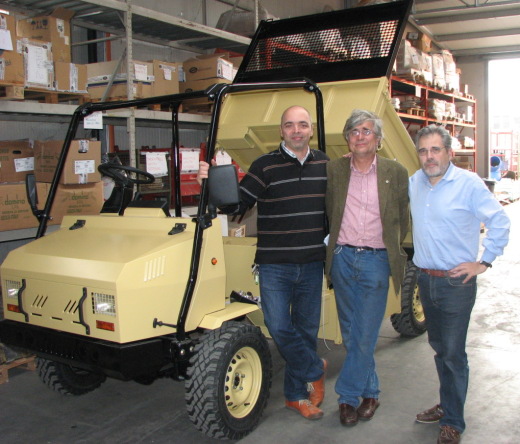Post-peak mechanized agriculture: the RAMSES project
Posted by Big Gav in agriculture, electric vehicles
Ugo Bardi has a post at TOD on an experiment in creating an electric vehicle for use in agriculture - Post-peak mechanized agriculture: the RAMSES project.
About three years ago, Ugo Bardi (your author) and Toufic El Asmar (agronomist at the University of Florence, Italy) sat together and conceived the idea of a complete, renewable energy system that would provide both electric and mechanical power for agriculture. We gave it the name of "RAMSES", an acronym that stands for something like "renewable multipurpose agricultural systems for farmers". But, actually, "Ramses" is an ancient Egyptian word that means "born of the sun-god Ra" and that seemed to us an auspicious name for the idea (later on, we learned of another vehicle named "Ramses"; a modern Egyptian battle tank).
The idea of the RAMSES system is to couple a renewable energy source (in this case a photovoltaic plant) with a multipurpose, battery powered agricultural vehicle. The system also includes a stationary battery pack for energy storage. The energy produced can be used in the farm, stored in the vehicle's batteries, in the stationary batteries, or sold to the grid. The batteries of the vehicle can also be used for powering the farm if needed. It is a complete energy system that makes the farm - potentially - independent from fossil fuels.
Once we had thought of all this, we assembled a team able to build the system and we submitted the project to the European Commission which financed it under the 6th framework program. RAMSES is a multinational effort which includes four European countries (Italy, Poland, Spain and UK) and three Mediterranean ones (Jordan, Lebanon and Morocco). After almost three years of work, a complete prototype system has been assembled. ...
RAMSES doesn't claim to be the first electrical vehicle in agriculture, but it is an original idea under several respects: it has been designed from scratch as an electric vehicle, not as the retrofitting of an existing vehicle. Also, it was conceived with production in series in mind, not as destined to remain a single prototype. Finally, it is not just an electric vehicle, but a complete energy system designed for use in a world where fossil fuels are destined to become less and less abundant.
The RAMSES vehicle uses standard components which can be serviced or replaced with a minimum effort. It is powered by a 96 V, 12 kW dc brushed motor located in the center, in a position protected from damage. An auxiliary, on board 12 kW motor is used for powering external agricultural equipment and the hydraulic system. The motors are powered by 16 6V 180 Ah lead-gel batteries. The two battery packs can be connected in series at 96 volts, for street use, or in parallel, at 48 V, for the highest torque for off road use. This set of batteries is expected to be able to power the vehicle for a range of about 70-80 km on roads and for 2-4 h of work in the fields. The maximum speed on roads is around 45 km/h. The vehicle weighs 1700 kg, including the driver and has a capacity of about one ton load.
The photovoltaic plant that powers the vehicle has a maximum power of 12 kW and is based on monocrystalline, silicon panels. The stationary energy system is based a lead-acid battery pack of total storage capacity of 2000 Ah.






